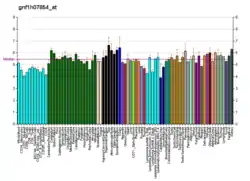Developmental pluripotency associated 2
Developmental pluripotency-associated protein 2 is a protein that in humans is encoded by the DPPA2 gene.[4][5][6]
| DPPA2 | |||||||||||||||||||||||||
|---|---|---|---|---|---|---|---|---|---|---|---|---|---|---|---|---|---|---|---|---|---|---|---|---|---|
| Identifiers | |||||||||||||||||||||||||
| Aliases | DPPA2, CT100, ECAT15-2, PESCRG1, Developmental pluripotency associated 2 | ||||||||||||||||||||||||
| External IDs | OMIM: 614445 MGI: 2157523 HomoloGene: 79572 GeneCards: DPPA2 | ||||||||||||||||||||||||
| |||||||||||||||||||||||||
| |||||||||||||||||||||||||
| |||||||||||||||||||||||||
| Orthologs | |||||||||||||||||||||||||
| Species | Human | Mouse | |||||||||||||||||||||||
| Entrez | |||||||||||||||||||||||||
| Ensembl | |||||||||||||||||||||||||
| UniProt | |||||||||||||||||||||||||
| RefSeq (mRNA) | |||||||||||||||||||||||||
| RefSeq (protein) | |||||||||||||||||||||||||
| Location (UCSC) | Chr 3: 109.29 – 109.32 Mb | n/a | |||||||||||||||||||||||
| PubMed search | [2] | [3] | |||||||||||||||||||||||
| Wikidata | |||||||||||||||||||||||||
| |||||||||||||||||||||||||
References
- GRCh38: Ensembl release 89: ENSG00000163530 - Ensembl, May 2017
- "Human PubMed Reference:". National Center for Biotechnology Information, U.S. National Library of Medicine.
- "Mouse PubMed Reference:". National Center for Biotechnology Information, U.S. National Library of Medicine.
- Du J, Lin G, Nie ZY, Lu GX (December 2004). "[Molecular cloning and characterization analysis of HPESCRG1, a novel gene expressed specifically in human embryonic stem cell.]". Zhonghua Yi Xue Yi Chuan Xue Za Zhi. 21 (6): 542–7. PMID 15583978.
- "Entrez Gene: DPPA2 developmental pluripotency associated 2".
- Klein, Rachel Herndon; Tung, Po-Yuan; Somanath, Priyanka; Fehling, Hans Joerg; Knoepfler, Paul S. (August 2018). "Genomic functions of developmental pluripotency associated factor 4 (Dppa4) in pluripotent stem cells and cancer". Stem Cell Research. 31: 83–94. doi:10.1016/j.scr.2018.07.009. ISSN 1876-7753. PMC 6133722. PMID 30031967.
Further reading
- Strausberg RL, Feingold EA, Grouse LH, et al. (2003). "Generation and initial analysis of more than 15,000 full-length human and mouse cDNA sequences". Proc. Natl. Acad. Sci. U.S.A. 99 (26): 16899–903. doi:10.1073/pnas.242603899. PMC 139241. PMID 12477932.
- Gerhard DS, Wagner L, Feingold EA, et al. (2004). "The status, quality, and expansion of the NIH full-length cDNA project: the Mammalian Gene Collection (MGC)". Genome Res. 14 (10B): 2121–7. doi:10.1101/gr.2596504. PMC 528928. PMID 15489334.
- Rual JF, Venkatesan K, Hao T, et al. (2005). "Towards a proteome-scale map of the human protein-protein interaction network". Nature. 437 (7062): 1173–8. doi:10.1038/nature04209. PMID 16189514. S2CID 4427026.
This article is issued from Wikipedia. The text is licensed under Creative Commons - Attribution - Sharealike. Additional terms may apply for the media files.


